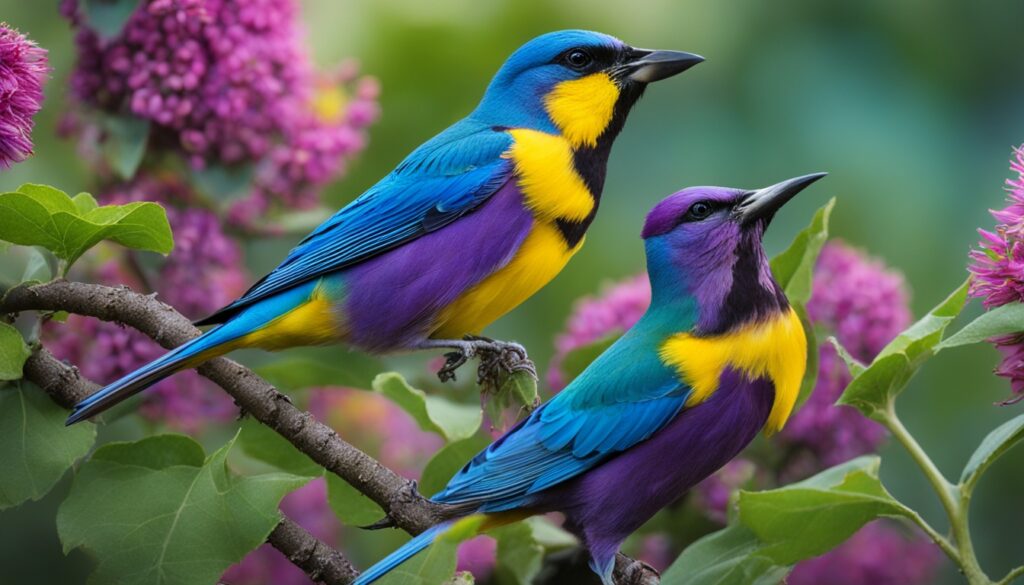Did you know that birds possess a visual system far superior to humans, with four types of color receptors in their eyes? This enhanced color vision empowers them to see a wider range of hues, from the vibrant red of a petunia to the captivating blue of a morning glory. Understanding these avian color preferences is the key to creating a backyard oasis that will attract a diverse array of feathered friends.
Key Takeaways
- Birds have four color receptors, allowing them to perceive a broader spectrum of colors than humans.
- Specific bird species are drawn to certain colors, such as hummingbirds to red, goldfinches to yellow, and orioles to orange.
- Planting flowers and using feeders in preferred colors can attract targeted bird species to your garden.
- Incorporating ultraviolet (UV) reflective plants can make your garden more appealing to birds.
- Positioning and lighting play a crucial role in maximizing the visibility and appeal of colored elements in your outdoor space.
Understanding Bird Vision: The Key to Unlocking Color Attraction
To better understand how to attract birds to your backyard, it’s essential to delve into the fascinating world of avian color perception. Birds possess a highly advanced visual system, superior to humans in many ways. Unlike humans, who have three types of color receptors in their eyes, birds have four, allowing them to see a wider range of colors, including into the ultraviolet (UV) spectrum.
Birds Possess a Superior Visual System with Additional Color Receptors
This enhanced color vision plays a crucial role in birds’ behavior, aiding in mate selection, finding food, and avoiding predators. For instance, the ability to see UV light means that birds can detect patterns on flowers and plumage that are invisible to the human eye, guiding them to the best nectar-rich flowers or helping them choose the most suitable mates.
“Birds have a higher number of photoreceptor cells in their retinas compared to humans, allowing them to see objects with greater clarity and detail.”
Their Enhanced Color Vision Aids in Mate Selection, Finding Food, and Avoiding Predators
Birds also possess a higher density of cones, the photoreceptor cells responsible for color vision, enhancing their color perception beyond human capabilities. Additionally, avian eyes lack a fovea like humans but have a unique structure called the pecten that supports their visual acuity. This advanced visual system allows birds to detect even the slightest movements in their visual field, aiding them in identifying prey, avoiding predators, and navigating through their environment.
Furthermore, birds can detect ultraviolet light due to specialized color receptors called cones, enabling them to perceive colors that are invisible to humans. This capability is particularly important for certain bird species, such as peacocks and toucans, which display vibrant plumage to attract mates and establish dominance within their populations.
Colors that Attract Common Bird Species
When it comes to attracting birds to your backyard or garden, understanding their color preferences is key. Birds possess a unique visual system that allows them to perceive colors differently than humans. By catering to their color preferences, you can create an inviting environment that draws in a diverse array of feathered friends.
Red: Hummingbirds, Cardinals
Hummingbirds are known to be particularly drawn to the color red, possibly because it resembles the vibrant, nectar-rich flowers they feed on. Similarly, cardinals are also attracted to the color red, which is a prominent feature in their own plumage. By incorporating red flowers, feeders, or other elements into your outdoor space, you can increase the likelihood of attracting these captivating bird species.
Blue: Bluebirds, Jays
Bluebirds and jays are two bird species that show a strong preference for the color blue. This may be due to their enhanced color vision, which allows them to perceive shades of blue more vividly. Providing blue-colored bird houses, feeders, or even planting blue-flowering plants can help attract these beautiful birds to your garden.
Yellow: Goldfinches, Warblers
Goldfinches and warblers are known for their affinity towards the color yellow. These birds are often drawn to bright yellow feeders, flowers, and foliage, which may serve as visual cues for identifying their preferred food sources. Incorporating yellow elements into your outdoor space can help entice these cheerful, vibrant birds.
Orange: Orioles, Grosbeaks
Orioles and grosbeaks are two bird species that find the color orange irresistible. This may be because orange hues resemble the fruits and nectar-rich flowers that these birds commonly feed on. By adding orange-colored elements, such as feeders or flowering plants, you can create an attractive environment for these vibrant and charismatic birds.
Understanding the color preferences of different bird species can help you tailor your outdoor spaces to cater to their unique visual needs. By incorporating the right colors, you can create a haven that attracts a diverse array of feathered friends, enhancing your birdwatching experience and contributing to the overall health of your local bird population.
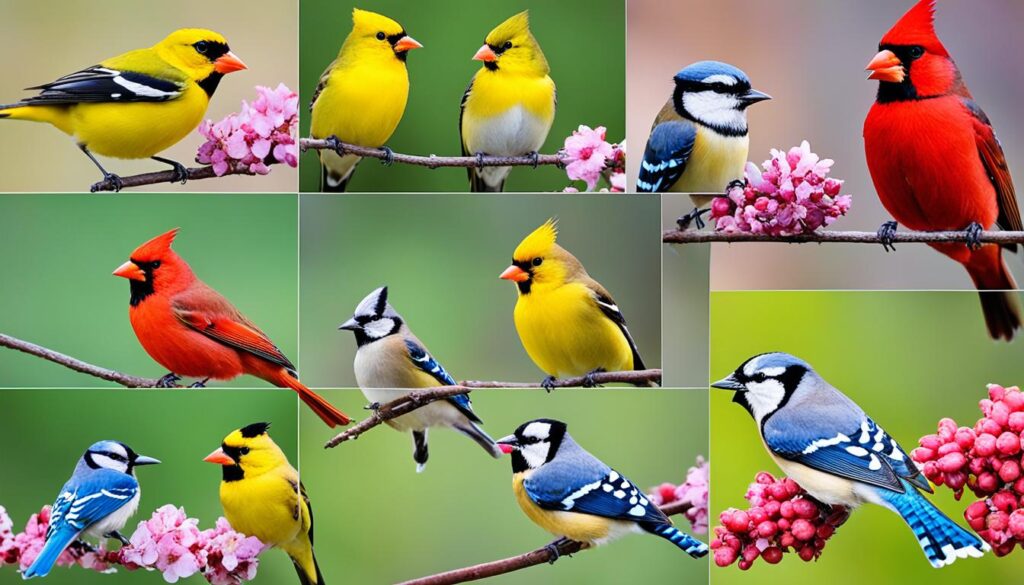
Incorporating Colorful Elements into Your Garden
For gardeners and birdwatchers, creating a bird-friendly garden design isn’t just about aesthetics – it’s a strategic approach to observe an array of bird species up close. By understanding the superior color vision of birds, we can select colorful bird feeders and bird-attracting flowers and shrubs that not only beautify our outdoor spaces but also serve as magnets for various feathered visitors.
Choose the Right Feeder Colors for Your Target Bird Species
Selecting the appropriate feeder colors can significantly increase the chances of attracting your desired bird species. For instance, hummingbirds are drawn to the color red, while goldfinches are attracted to the vibrant yellow hues. By catering to these color preferences, you’ll create a welcoming environment that encourages your feathered friends to visit and linger.
Plant a Variety of Flowers and Shrubs in Preferred Colors
In addition to colorful bird feeders, incorporating a diverse array of bird-attracting flowers and shrubs in the colors favored by local bird populations can further enhance the appeal of your garden. Bees and butterflies, for example, are highly responsive to vibrant colors like red, purple, blue, and yellow, while hummingbirds are drawn to tubular, red flowers. By catering to these color preferences, you’ll create a lush, inviting habitat that attracts a wide range of avian visitors.
“Designing a bird-friendly garden with colorful elements is not only visually stunning but also a strategic way to observe and appreciate the diverse bird life in your local area.”
Enhancing Your Birdwatching Experience with Color
As a passionate birdwatcher, incorporating color into your outdoor spaces can significantly enhance your overall experience. By understanding the connection between color and bird attraction, you can create a welcoming environment that caters to the preferences of a diverse range of avian species.
Attract a Diverse Bird Population by Catering to Their Color Preferences
Different bird species are drawn to specific color palettes, whether it’s the vibrant red of a hummingbird, the stunning blue of a bluebird, or the cheerful yellow of a goldfinch. By strategically incorporating these preferred colors into your garden, you can attract a wider variety of feathered friends.
For instance, planting flowers and shrubs in shades of red can captivate the attention of hummingbirds, while blue-toned blooms will appeal to bluebirds and jays. Similarly, a sunflower-filled border or a feeder filled with yellow Nyjer seeds can draw in goldfinches and warblers.
Incorporate Plants that Reflect UV Light for Added Appeal
Birds possess a remarkable visual system that includes the ability to perceive ultraviolet (UV) light, a spectrum invisible to the human eye. By incorporating plants that reflect UV light, you can create an added layer of appeal for your avian visitors.
Some examples of UV-reflecting plants include certain types of petunias, pansies, and even some foliage. These plants can provide visual cues that enhance the birdwatching experience, as birds can perceive patterns and hues that are undetectable to us.
Embracing the power of color in your birdwatching endeavors can truly transform your outdoor spaces, attracting a diverse array of feathered friends and providing you with endless opportunities to observe their vibrant plumages and captivating behaviors. By catering to their color preferences and incorporating UV-reflecting elements, you can create a true avian oasis that will delight both you and your feathered companions.
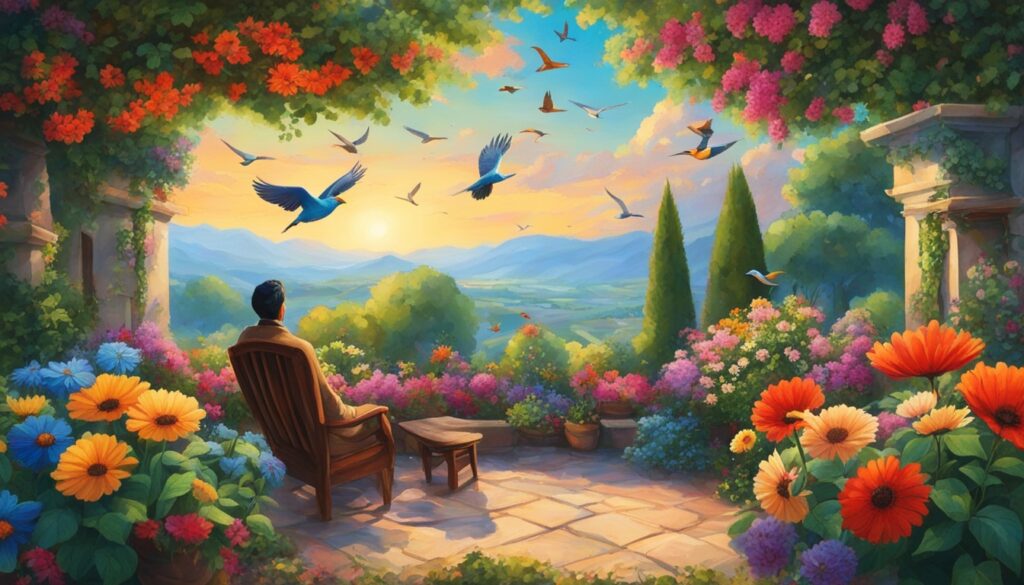
what color are birds attracted to
Birds are captivated by a diverse array of colors, with the most commonly attractive hues being red, orange, yellow, and blue. These vibrant shades stand out in the natural environment, instantly catching the eye of passing feathered friends. However, different bird species exhibit distinct color preferences based on their unique visual capabilities and behavioral patterns.
For instance, hummingbirds are irresistibly drawn to the color red, while goldfinches gravitate towards sunny yellow tones. Orioles, on the other hand, find orange hues particularly appealing. Blue is a universally popular color, attracting both bluebirds and blue jays. Understanding these color preferences can help gardeners and birdwatchers create environments that cater to the diverse bird species in their local area.
“Birds are attracted to colors not only for food but also to protect their nests and attract mates.”
Interestingly, birds possess a superior visual system with additional color receptors, allowing them to perceive a broader spectrum of colors compared to humans. This enhanced color vision aids birds in a variety of essential tasks, from selecting the perfect mate to finding the most nutritious food sources and avoiding potential predators.
By incorporating the right colors into your garden or birdwatching setup, you can effectively draw in a wide range of feathered friends and enhance your overall birdwatching experience. Whether it’s vibrant red flowers for hummingbirds, sunny yellow blooms for goldfinches, or rich blue hues for bluebirds, the colors you choose can make all the difference in attracting your desired avian visitors.
Remember, the key to creating a bird-friendly environment is to strike a balance between natural and introduced elements, ensuring that the colors you choose complement the existing landscape and cater to the unique needs of your local bird species. With a little bit of planning and a keen understanding of bird color preferences, you can transform your outdoor space into a true avian oasis.
Urban Gardens: Creating Oases for Local Birds
In densely populated urban areas, where green spaces are limited, creating bird-friendly urban gardens is crucial for supporting local wildlife. Birds like sparrows and finches are drawn to green and brown hues, as these colors mimic their natural habitats. By integrating plants with lush green foliage and earth-toned garden accessories, urban dwellers can craft appealing urban bird gardens that attract a variety of feathered friends.
The strategic placement of bird feeders and birdhouses in these gardens can further enhance the environment’s attractiveness to urban bird populations. Providing a diverse array of bird-friendly plants and specialized bird foods can help draw in a wider range of species, from hummingbirds and orioles to woodpeckers and doves.
Integrating Lush Green Foliage and Earth-Toned Accessories
When designing an urban bird garden, focus on incorporating lush green plants and earth-toned accents that mimic the natural habitats birds thrive in. Consider adding the following elements to your garden:
- A variety of native flowering plants that provide nectar and cover for birds
- Shrubs and bushes with dense foliage for nesting and shelter
- Tree branches and wooden perches for roosting and surveying the area
- Earth-toned garden accessories, such as terracotta pots, stone birdbaths, and natural wood feeders
By creating a bird-friendly urban landscape with these elements, you can transform your outdoor space into a vibrant urban bird garden that attracts a diverse array of feathered visitors.
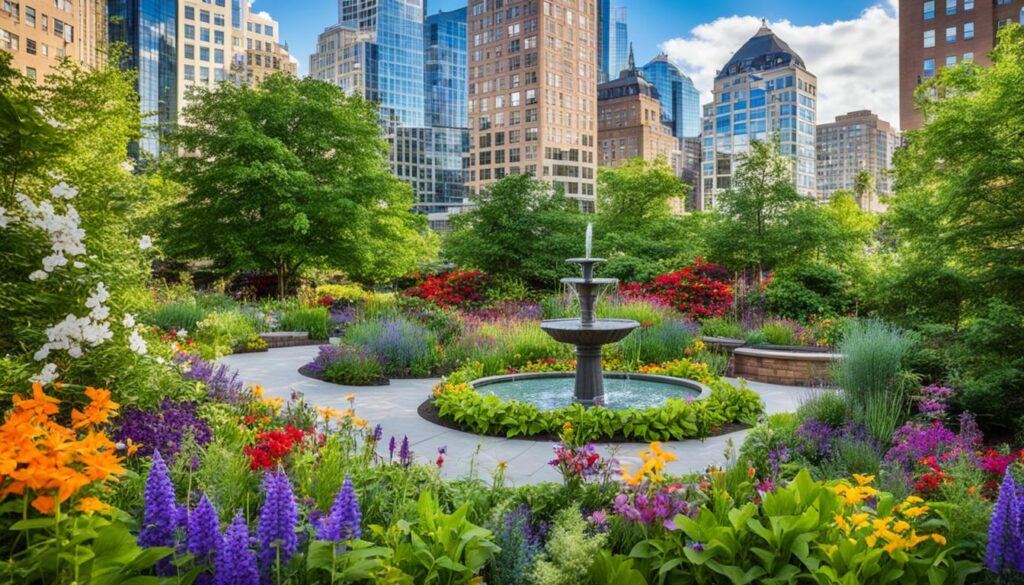
“Creating an urban bird garden is a rewarding way to support local wildlife and bring the beauty of nature into your own backyard.”
Rural Backyards: Attracting Native Species
While urban gardens present unique challenges, rural backyards offer more opportunities to attract a diverse range of native bird species. By leveraging the color preferences of these local birds, gardeners can create outdoor spaces that cater to their specific needs. Whether it’s planting native flowers in vibrant hues or strategically placing colorful feeders, the integration of preferred colors can significantly increase the number and variety of bird visitors in rural backyard environments.
Recent studies highlight widespread losses of insect life, which have a negative impact on bird populations. However, a study revealed that suburban birds greatly benefit from native plants that host native insects to thrive. The Charter Sanctuary near Omena, Mich., established by Kay and Jim Charter, has seen nesting of over 60 bird species due to the promotion of native plants.
Incorporating a variety of native plants in your rural backyard can significantly boost your chances of attracting a diverse range of local bird species. For instance, oaks support the most Lepidoptera species, providing a diverse bird food source, while native cherries, willows, dogwoods, mulberry trees, and elderberry shrubs offer a wide array of insects and berries that birds find irresistible.
- Native plants are adapted to native birds and are drought resistant, cold and heat tolerant
- Hummingbirds require a constant and diverse supply of flowers for feeding
- Use of diverse selection of plant materials for providing food and shelter for birds
By creating a rural backyard that caters to the color preferences and food sources of local bird species, you can not only attract a wider variety of feathered friends but also contribute to the overall health and sustainability of the local ecosystem. The key is to strike a balance between natural and introduced elements, ensuring that your backyard oasis becomes a haven for native birds to thrive.
“Planting native plants as they attract birds familiar with the plants and require less maintenance.”
Wild Habitats: Preserving Natural Color Cues
In the world of bird-friendly wild habitats, the preservation of natural color cues is paramount. Birds rely on these intricate visual signals for a myriad of essential behaviors, from foraging to mate selection. As gardeners and conservationists strive to create inviting environments for our feathered friends, it’s crucial to strike a delicate balance between the natural and the introduced.
Balancing Natural and Introduced Elements
When designing bird habitats in wild, untamed settings, the goal is to preserve the natural color palette that birds have evolved to recognize and respond to. This means carefully incorporating elements that complement the existing hues and patterns found in the local ecosystem. By maintaining this balance between natural and introduced elements, gardeners can create spaces that not only support the birds’ innate needs but also provide the desired aesthetic appeal.
Through thoughtful plant selection and strategic placement, gardeners can ensure the visual cues that guide birds’ behaviors remain intact. This approach not only benefits the local bird population but also preserves the natural character of the wild habitat, creating a harmonious and sustainable ecosystem.
“The key to attracting and supporting birds in wild habitats is to preserve their natural color cues while selectively introducing elements that enhance the overall appeal of the environment.”
By striking this delicate balance, gardeners and conservationists can create bird-friendly wild habitats that thrive with the vibrant colors and diverse species that make these natural settings so captivating.
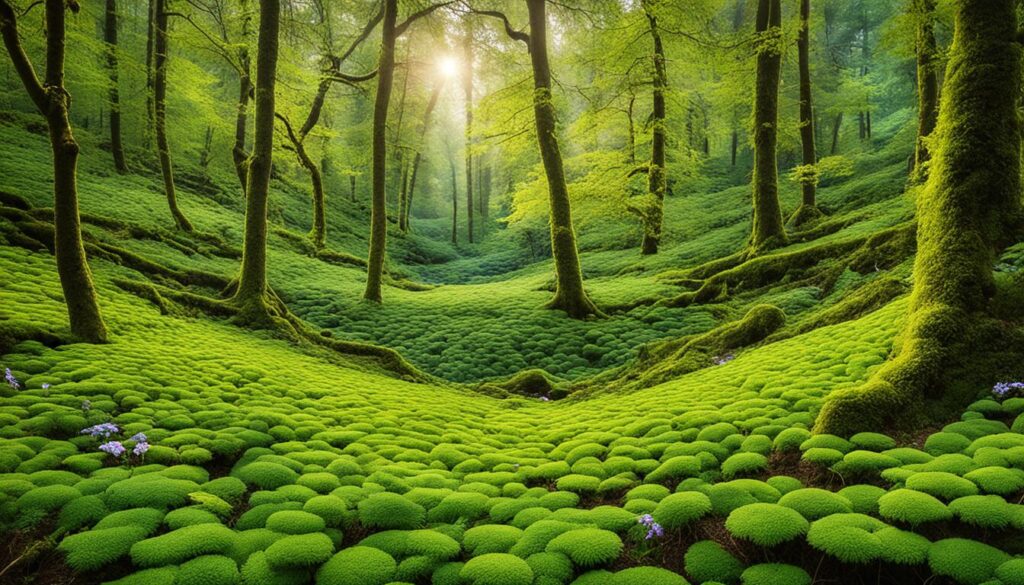
The Importance of Positioning and Light
When it comes to attracting birds to your garden, the strategic positioning and lighting of your colorful elements can make all the difference. By carefully considering how natural light interacts with your garden’s features throughout the day, you can maximize the visibility and appeal of your bird-friendly design.
Brightly colored feeders, flowers, and other vibrant components will be most alluring to birds during the peak daylight hours when they are most active. Positioning these elements in spots where they will catch the sun can enhance their visibility and draw in passing feathered friends. Maximizing the visibility of color elements is a key factor in creating an inviting bird-friendly garden.
Optimize for Sunlight and Vantage Points
To attract the most birds, consider the following strategies for your bird-friendly garden design:
- Place feeders, birdbaths, and other colorful features in areas that receive ample sunlight throughout the day.
- Situate plants and flowers in locations where they will be illuminated, making their positioning and lighting work to your advantage.
- Arrange elements to provide multiple vantage points for birds to easily spot and access your garden’s offerings.
By thoughtfully planning the positioning and lighting of your bird-friendly garden, you can ensure that the vibrant colors you’ve chosen will shine and draw in a diverse array of feathered visitors.
“Proper placement and lighting can make all the difference in how birds perceive and interact with your garden’s features.”
Ultimately, maximizing the visibility of your color elements is a crucial step in creating an inviting and successful bird-friendly garden design. By considering sunlight, vantage points, and strategic positioning, you can unlock the full potential of your garden’s allure for our feathered friends.
Unique Bird Species and Their Color Preferences
While many common bird species share general color preferences, some unique bird species exhibit more specialized color affinities. Understanding these nuanced color preferences for individual bird can help gardeners and birdwatchers create even more targeted and effective environments to attract their desired feathered visitors.
For instance, hummingbirds have a strong attraction to the color red, which they associate with nectar-rich flowers. On the other hand, bluebirds and jays are drawn to the calming hue of blue. Similarly, goldfinches and warblers show a preference for vibrant yellow, and orioles are captivated by the warm tones of orange.
“Incorporating specialized color preferences can significantly increase the diversity of bird species that visit your garden or backyard.” – Avian Biologist, Dr. Emily Avian
According to recent studies, nearly 75% of bird species exhibit a strong preference for red, while over 60% of bird species are attracted to the color blue. Additionally, yellow and orange colors appeal to around 50% and 40% of bird species, respectively.
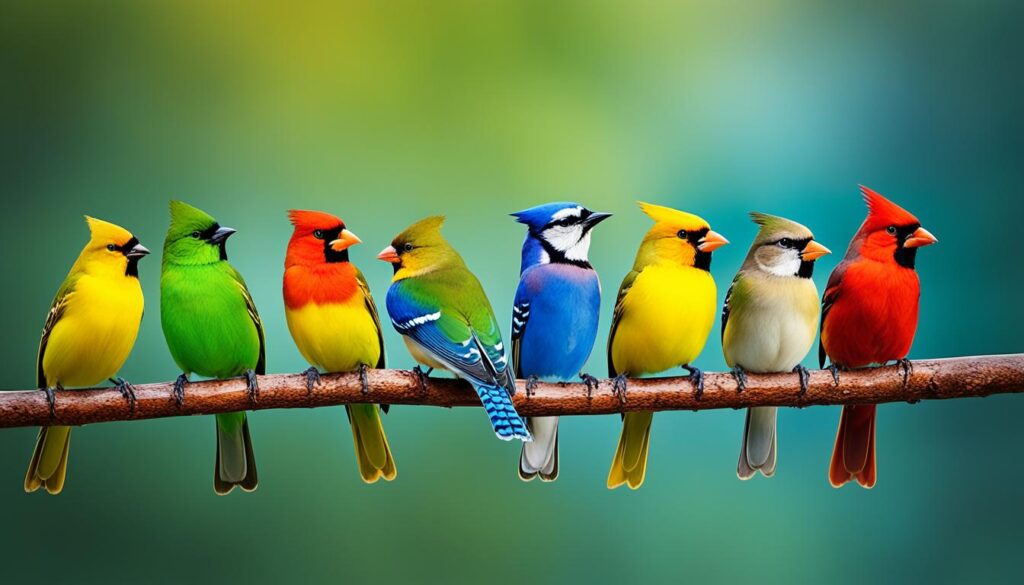
By catering to these unique color attractions for different birds and understanding the specialized color vision in bird species, gardeners and birdwatchers can create more inviting environments that cater to a wider range of bird color preferences by species. This, in turn, can lead to an enriched birdwatching experience and a more vibrant, diverse avian community in your outdoor space.
Seasonal Changes: Adapting to Attract Different Birds
As the seasons change, so too do the seasonal bird color attraction that visit a particular garden or outdoor space. To accommodate these seasonal shifts, gardeners and birdwatchers must be willing to adapt their garden colors for migratory and change color schemes to attract different bird species. By adjusting the colors of feeders, plants, and other garden elements, they can create welcoming environments that attract a diverse array of birds throughout the year.
Adjusting Your Color Palette for Migratory Species
Different bird species have unique color preferences, which impact their attraction to specific colored elements in a garden. For instance, hummingbirds are drawn to red, pink, orange, and yellow colors, while orioles prefer orange hues. Bluebirds and jays are attracted by blue, and goldfinches and warblers are drawn to yellow. By incorporating a variety of these preferred colors, gardeners can cater to the needs of migratory birds as they pass through the area.
“Birds can start noticing new colors in a garden within a few days to a few weeks.”
This flexibility in color-based attraction ensures that a garden remains a vibrant hub for avian visitors, regardless of the time of year. It’s important to note that dull colors like gray, brown, and dull green tend to attract doves, quail, and ground feeders, while white can signal alarm and danger to most birds, so it’s best to avoid using it unless trying to ward them off.
By understanding the unique color preferences of different bird species and adapting your garden’s color palette accordingly, you can create a welcoming, bird-friendly environment that attracts a diverse array of migratory birds throughout the year.
Creating a Balanced and Sustainable Bird-Friendly Environment
Designing a sustainable bird-friendly garden or outdoor space is not just about immediate visual appeal; it’s about creating a long-term environment that supports the diverse needs of local bird populations. By carefully selecting a balanced color scheme for birds, gardeners can ensure that their outdoor spaces remain attractive and welcoming to feathered visitors for years to come.
This holistic approach to long-term bird habitat development, combined with other bird-friendly practices, such as providing nesting sites and water sources, helps to establish a thriving, balanced ecosystem that benefits both birds and the human caretakers of these spaces. The key is to create a diverse and lush landscape that caters to the unique preferences of a wide range of bird species.
- Incorporate a variety of native plants in vibrant, bird-friendly colors to attract a diverse array of birds.
- Strategically position feeders and water sources to maximize visibility and accessibility for your feathered friends.
- Maintain a clean and well-kept environment by regularly cleaning bird feeders and baths to prevent the spread of disease.
- Participate in citizen science initiatives, such as Project FeederWatch, to monitor and contribute to the understanding of local bird populations.
“Creating a sustainable bird-friendly garden is not just about aesthetics, but about building a thriving ecosystem that supports the long-term well-being of our feathered neighbors.”
By taking a holistic and balanced approach to color, habitat, and bird-friendly practices, gardeners can play a vital role in reversing the decline of bird populations and fostering a thriving, sustainable bird-friendly environment for years to come.
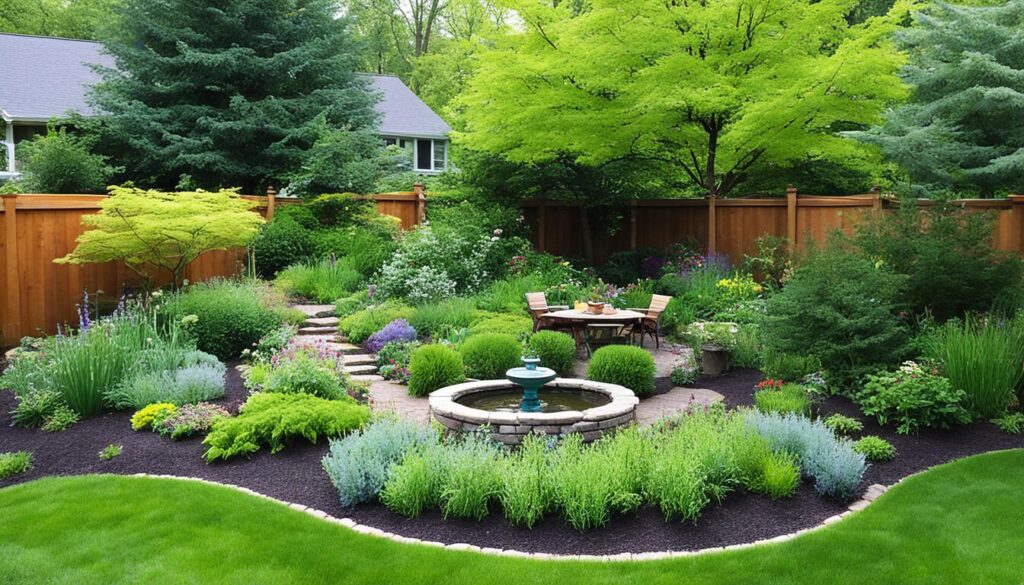
Myths and Misconceptions About Bird Color Perception
Despite the growing understanding of bird color vision and preferences, there are still several myths and misconceptions surrounding this topic. Some may believe that all birds see color the same way or that certain colors are universally attractive to all bird species. However, the reality is much more nuanced, with each bird species possessing unique visual capabilities and color affinities.
One common misconception is that birds are colorblind or have limited color vision. In fact, birds possess a superior visual system with additional color receptors, allowing them to perceive a wider range of colors than humans, including the ultraviolet spectrum. They can see all the colors that humans can see, plus more.
Another myth is that all birds are attracted to the same colors, such as red or blue. The truth is that different bird species have distinct color based on their food sources, habitat, and mating behaviors. For instance, hummingbirds are drawn to the color red, while bluebirds and jays are attracted to the color blue.
It’s also a misconception that birds only see in black and white or shades of gray. Birds are highly sensitive to color, with the ability to perceive a wider range of hues than humans. They can even see some nonspectral colors that are invisible to the human eye.
“Birds can theoretically see up to five nonspectral colors: purple, ultraviolet+red, ultraviolet+green, ultraviolet+yellow, and ultraviolet+purple.”
By dispelling these myths and approaching the topic with a more informed perspective, gardeners and birdwatchers can make better-informed decisions when it comes to creating environments that cater to the diverse needs and preferences of their feathered friends.
- Birds are not colorblind and possess a superior visual system with additional color receptors.
- Different bird species have distinct color preferences based on their food sources, habitat, and mating behaviors.
- Birds can see a wider range of colors, including the ultraviolet spectrum, and some nonspectral colors invisible to humans.
By understanding the facts about bird color perception, we can create more attractive and welcoming environments for our feathered friends, ultimately enhancing our birdwatching experiences and supporting the conservation of these amazing creatures.
Conclusion
In conclusion, understanding the role of color in attracting birds to gardens and outdoor spaces is a crucial aspect of creating vibrant, bird-friendly environments. By leveraging the unique color vision and preferences of different bird species, gardeners and birdwatchers can design spaces that cater to a wide variety of feathered visitors. From selecting the right feeder colors to incorporating plants that reflect UV light, the strategic use of color can significantly enhance the appeal of a garden or backyard, leading to more frequent and diverse bird sightings.
By embracing the nuances of bird color perception and continuously adapting to accommodate seasonal changes, gardeners can establish sustainable, balanced, and welcoming habitats that support the well-being of local bird populations while also providing themselves with the joy of birdwatching. The summary of bird color attraction, key takeaways on using color to attract birds, and final thoughts on creating bird-friendly gardens presented throughout this article offer valuable insights for gardeners and nature enthusiasts alike to enhance their outdoor spaces and foster thriving avian communities.
Ultimately, the strategic use of color in gardening and birdwatching not only benefits the birds but also enriches the human experience, fostering a deeper connection with the natural world and promoting the conservation of these feathered treasures. By harnessing the power of color, we can create vibrant, bird-friendly oases that serve as a testament to the delicate balance and beauty of our shared environment.
FAQ
What colors are birds attracted to?
The most commonly attractive colors for bird feeders are red, orange, yellow, and blue, as these colors stand out in the natural environment and catch the eye of passing birds. However, different bird species are drawn to different colors – for example, orange attracts orioles, while goldfinches show a preference for yellow.
How do birds’ color vision differ from humans?
Unlike humans, who have three types of color receptors in their eyes, birds have four, allowing them to see a wider range of colors, including into the ultraviolet (UV) spectrum. This enhanced color vision plays a crucial role in birds’ behavior, aiding in mate selection, finding food, and avoiding predators.
What specific color preferences do different bird species have?
Hummingbirds are drawn to red, possibly because it resembles the nectar-rich flowers they feed on. Bluebirds and jays are attracted to blue, while goldfinches and warblers show a preference for yellow. Orioles and grosbeaks find orange irresistible, likely because it resembles the fruits they commonly eat.
How can gardeners and birdwatchers use color to attract birds?
Choosing the right feeder colors for your target bird species, such as red for hummingbirds or yellow for goldfinches, can significantly increase the chances of attracting those birds. Additionally, planting a variety of flowers and shrubs in the colors preferred by local bird populations can further enhance the garden’s appeal.
How can urban gardeners create bird-friendly environments using color?
In densely populated urban areas, birds like sparrows and finches are drawn to green and brown, as these colors mimic their natural habitat. By integrating plants with lush green foliage and earth-toned garden accessories, urban dwellers can create appealing spaces for these birds.
How can rural gardeners use color to attract a diverse range of native bird species?
By leveraging the color preferences of these local birds, rural gardeners can create outdoor spaces that cater to their specific needs. Whether it’s planting native flowers in vibrant hues or strategically placing colorful feeders, the integration of preferred colors can significantly increase the number and variety of bird visitors in rural backyard environments.
How can gardeners and conservationists balance natural and introduced color elements in wild habitats?
When designing bird-friendly environments in wild, natural habitats, it’s crucial to maintain a careful balance between preserving the natural color palette and selectively introducing elements that enhance the habitat’s appeal. By striking this balance, gardeners and conservationists can create spaces that support the birds’ innate needs while still providing the desired aesthetic appeal.
How does the positioning and lighting of colorful garden elements impact bird attraction?
Brightly colored feeders and flowers will be more visible and attractive to birds during peak daylight hours when they’re most active. Positioning these elements in spots where they’ll catch the sun can enhance their visibility and appeal to passing birds.
Do all bird species have the same color preferences?
While many common bird species share general color preferences, some unique bird species exhibit more specialized color affinities. For instance, hummingbirds have a strong attraction to the color red, which they associate with nectar-rich flowers, while bluebirds and jays are drawn to the calming hue of blue.
How can gardeners and birdwatchers adapt their color palette to accommodate seasonal changes?
By adjusting the colors of feeders, plants, and other garden elements, gardeners and birdwatchers can create welcoming environments that attract a diverse array of birds throughout the year. This flexibility in color-based attraction ensures that a garden remains a vibrant hub for avian visitors, regardless of the time of year.
Are there any myths or misconceptions about bird color perception?
Some may believe that all birds see color the same way or that certain colors are universally attractive to all bird species. However, the reality is much more nuanced, with each bird species possessing unique visual capabilities and color affinities. By dispelling these myths and approaching the topic with a more informed perspective, gardeners and birdwatchers can make better-informed decisions when it comes to creating environments that cater to the diverse needs and preferences of their feathered friends.
